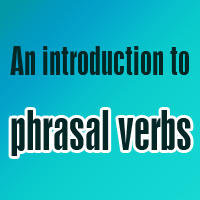
What are phrasal verbs?
A phrasal verb (also called multi-word verb) consists of two parts; a verb and a particle (preposition / adverb, or a combination thereof).
Compare these two examples:
Verb sentence: Norman takes his coat.
Phrasal verb sentence: Norman takes off his coat. (Norman removes his coat from his body)
In the second example, the meaning of the sentence is completely different. The particle (in this case off) changes the meaning of the verb. Quite often, there is a single-word verb which means the same thing as the multi-word verb. In the example above; take off = remove. Especially for beginners, English phrasal verbs can be very difficult because it is often not possible to translate the phrasal verbs literally.
When and how are phrasal verbs used?
Phrasal verbs or multi-word verbs are mostly used in spoken English and informal writing. Using phrasal verbs in conversation brings you one step closer to sounding like a native speaker.
Have a look at the next example:
Phrasal verb sentence: It's getting dark; let's go in (the house).
Verb sentence: It's getting dark; let's enter the house.
The second sentence is grammatically correct and has the same meaning as the phrasal verb sentence, but sounds a lot more formal und unnatural.
There are four types of phrasal verbs:
- Intransitive - These phrasal verbs do not take a direct object. That means the sentence makes sense without an object! Example: Jill sat down.
- Transitive with inseparable object - These phrasal verbs need a direct object and this can't go between the verb and the particle. Example: I can't come to the party tonight, I have to look after my little sister.
- Transitive with separable object - These phrasal verbs need a direct object and this can go between the verb and the particle. Example: Norman takes off his jacket / Norman takes his jacket off.
- Transitive with two particles - In these phrasal verbs the particles are inseparable! Example: You really shouldn't run around after him anymore, he's old enough to do it himself.
Caution! Sometimes what looks like a multi-word verb isn't one at all, but rather just a verb and a preposition. It depends on the context.
Example:
Jane looked up. (Here the preposition up just describes the direction in which she looks. No phrasal verb)
Jane told me that things are looking up again. (Here, to look up is a phrasal verb, meaning her situation is improving again.)
How do I best learn them?
Sometimes it's easy to guess the meaning of the phrasal verbs (sit down, go away, paint over), but quite often the meaning of a multi-word verb is not so obvious (itch for, slip by, flick off). In this case you have to use a dictionary and learn the meaning of these expressions.
A good way to become more familiar with phrasal verbs is to look for them when you read something. Underline them and guess or look up their meaning.
As a rule of thumb you could say that phrasal verb are a bit more informal and often used in conversation. Their single-word verb counterparts on the other hand are slightly more formal.
There's no way around it, start learning phrasal verbs now! :-)
Below are a few Amazon (affiliate) links to useful books for beginners / intermediate students: Phrasal verb dictionary: Oxford Phrasal Verbs Dictionary: For Learners of English (Diccionarios) Workbook: Really Learn 100 Phrasal Verbs: Learn the 100 Most Frequent and Useful Phrasal Verbs in English in Six Easy Steps (Usage)
Vocabulary (in order of appearance)
- to consist of: to be formed from
- thereof: of the thing mentioned
- literally: (here) word for word
- inseparable: always together
- to become more familiar: (here) to get to know something better
- rule of thumb: (idiom) a method developed through experience rather than exact measurement
- counterpart: something that has the same position than something else in a different situation / place
 Instagram
Instagram